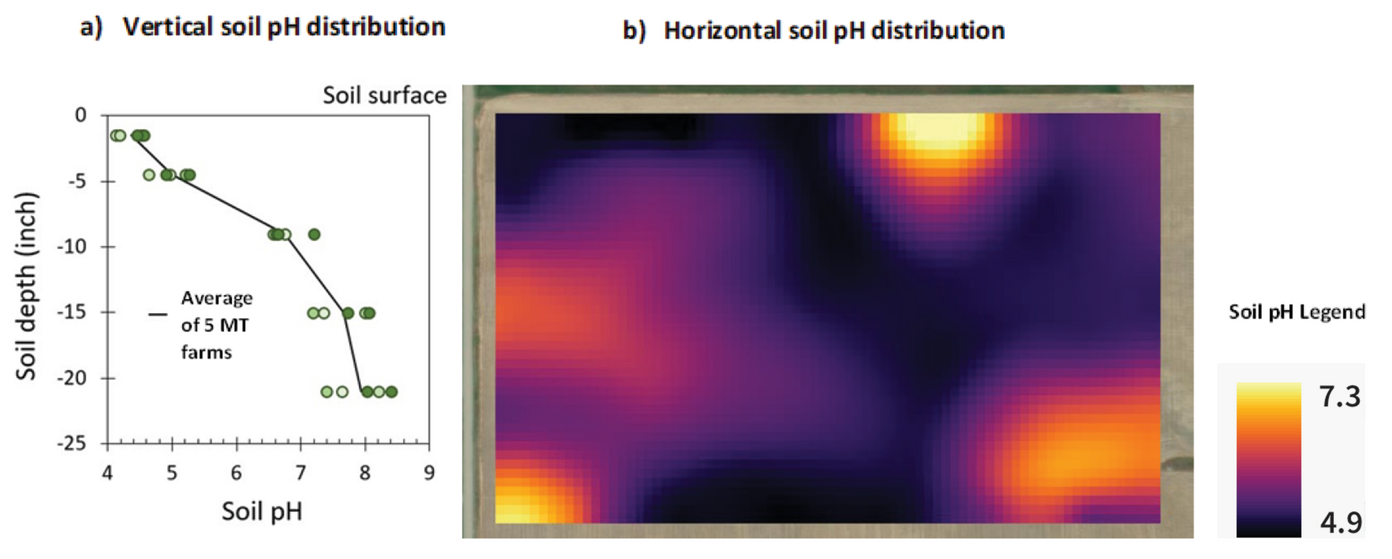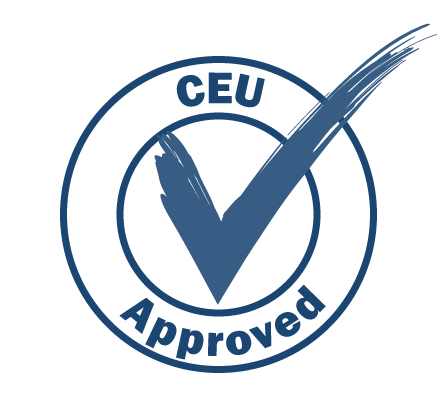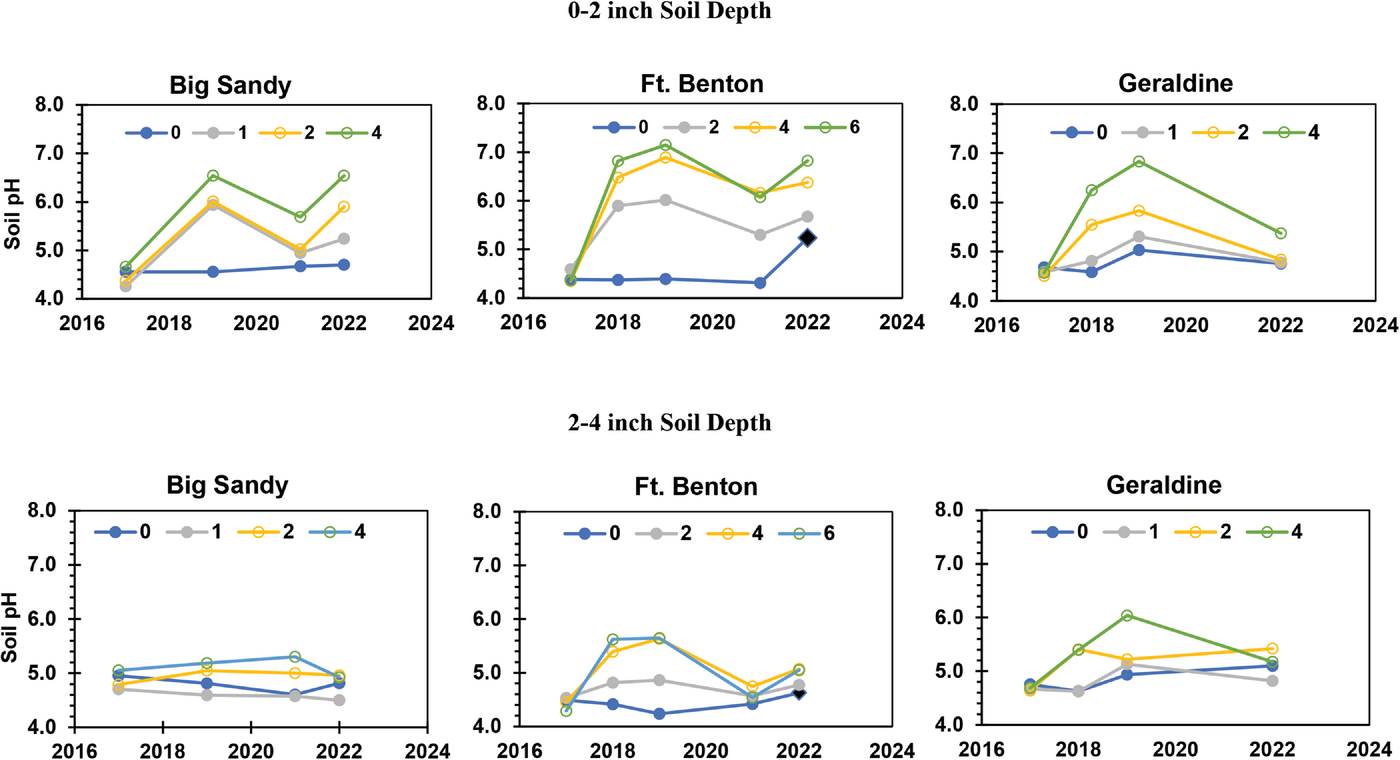Lime Management to Increase Soil pH in Semi-Arid Regions of the U.S.


Soil acidification, a common issue in high-rainfall areas of the U.S. and Canada, has become a more prevalent problem in the semi-arid areas of the western U.S. Liming is an effective way to mitigate soil acidity as the carbonate reacts with hydrogen ions in the soil solution to increase the soil pH. However, questions exist about the type of liming product, lime rate, cost effectiveness, and how long the lime benefits last, especially in regions that have historically not needed lime, like much of the Great Plains. Earn 0.5 CEUs in Soil & Water Management by reading the article and taking the quiz at https://web.sciencesocieties.org/Learning-Center/Courses.
Soil acidification, a common issue in high-rainfall areas of the U.S. and Canada, has become a more prevalent problem in the semi-arid areas of the western U.S. In Montana alone, 24 of 56 counties have at least one cropland field with a soil pH less than 5.5, and there are likely at least 500,000 acres below that pH. Most of these locations are under wheat production. The likely cause of the acidity is nitrification of ammonium-based fertilizers (e.g., urea), which have seen tremendous application increases since 1985 to obtain protein premiums and increase crop yields.
Low pH dissolves a portion of naturally occurring soil aluminum, which is highly toxic to crops. Other negative effects of soil acidity include reduced activity of nitrogen-fixing bacteria in legumes, increased fungal diseases, herbicide persistence, and low nutrient availability. While prevention is the key to avoiding soil acidity, mitigation strategies are needed to raise the soil pH when low pH causes unacceptable crop losses.
Liming is an effective way to mitigate soil acidity as the carbonate reacts with hydrogen ions in the soil solution to increase the soil pH. However, questions exist about the type of liming product, lime rate, cost effectiveness, and how long the lime benefits last, especially in regions that have historically not needed lime, like much of the Great Plains.
Accurate pH Characterization to Allow Variable-Rate Lime Application
The first step in mitigation is to accurately characterize the soil pH. Soil pH varies both vertically and horizontally. Based on data from Montana, soil pH is considerably lower near the soil surface and can vary from 4.9 to 7.3 even within a 50-ac field (Figure 1). The results have implications for accurately detecting the extent of soil acidity and preparing a lime management plan.
It is recommended to grid or zone sample, rather than composite soil across fields, and collect soil samples from 0 to 3 inches instead of 0 to 6 inches to better detect areas with low soil pH. Such sampling schemes would provide the data for site-specific liming to save money. Grid sampling could be labor and time intensive. Preliminary data from Montana indicates some good potential of using remote sensing or on-the go sensor technology such as Veris (MSP3, Veris Technologies, KS) to detect soil pH variability (Nugent et al., unpublished data).
Liming Products and Mode of Application
Liming products vary in their composition, mesh size, cost, and feasibility of application. Sugarbeet lime is a by-product of the sugar industry and is freely available but can cost up to $145/ac when considering the hauling cost to around 250 miles and high rates needed (up to 4 ton/ac). Sugarbeet lime application also requires special spreading equipment, which can cost about $60,000 for large variable rate spreaders. Other products are prilled or pelletized lime, which can cost $250 to 300/ton, and aglime, which costs around $55/ton, excluding shipping and application cost.
We examined the efficacy of different liming products (aglime, sugarbeet lime, and prilled lime) and method of application (incorporated with tillage, surface-applied with no-till, and seed-drilled). The application rate of aglime and sugarbeet lime was determined based on calcium carbonate equivalent and buffer test, targeting a pH of 6.2 (1–4 tons lime/ac), whereas prilled lime rate was 250 lb/ac based on the feasibility to utilize a seed drill.

The results indicated that incorporating sugarbeet lime is the most effective way of raising soil pH, but no-till beet lime also increased the pH levels into the optimum pH zone (6.5–7.5) in this 2023 study (Figure 2). Growing season precipitation was much higher in 2023 than most years, which likely helped move beet lime in the no-till treatment. The results suggest that freely available lime products (e.g., sugarbeet lime) are as, or more, effective as costly lime products (e.g., aglime) to raise soil pH. Prilled lime, which was seed-drilled (250 lb/ac) to investigate as an option for no-till farmers, was not an effective strategy to raise pH or improve crop yields.
How Long Do Lime Benefits Last in Semi-Arid Environment?
A study from Saskatchewan indicated that a single application of lime improved soil pH and crop yields for 16 to 27 years (Malhi et al., 1995). However, the duration of lime impacts in somewhat warmer and drier environments is relatively unknown. We tested the efficacy of different lime rates (0 to 4 ton/ac) to raise pH at three on-farm sites in Montana over a five-year period (Figure 3). Sugarbeet lime was applied in fall 2017. The application of lime increased the soil pH at all sites at the 0- to 2-inch soil depth; however, by 2022, pH decreased from the 2019 peak at all sites except Big Sandy (Figure 3). A drop in pH below 5.5 at Geraldine indicates that re-application of lime could be needed after five years to raise pH to the optimum pH zone at least in some soils. At the other two sites, even though surface pH was above 6, pH at 2 to 4 inches was below 5.5, which could negatively affect the crop growth. It is important to consider that 2 to 4 inches is in, or directly below, the seeding zone; therefore, an optimum pH could be critical in that soil zone.

The highest rate at each site (4 or 6 tons/ac) increased soil pH the most whereas 1 and 2 tons/ac were not able to keep the soil pH in the optimum zone by 2022 at two of the sites, even in the upper 2 inches. At the Big Sandy site where lime was not tilled, no pH increase occurred at 2 to 4 inches over the five-year period, demonstrating that there is not enough moisture to dissolve and move lime below 2 inches in a low annual precipitation zone (14 inches). This is a disappointing finding given the importance of no-till at reducing wind erosion losses and conserving moisture. This stresses the importance of catching low soil pH before it becomes a problem as liming is expensive and requires tillage to be effective in dry environments prone to wind erosion.
Summary/Takeaways
1. Precise soil pH monitoring is required to detect soil acidity issues; compositing soil samples across field landscapes and soil depths can mask the issue.
2. Site-specific lime management can reduce lime costs to growers and avoid application to high-pH areas.
3. Freely available products such as sugarbeet lime could be as, or more, effective as costly products such as aglime and prilled lime.
4. Lime may need to be re-applied after five years under semi-arid environments to keep the soil pH in the optimum zone of 6.5 to 7.5.
Acknowledgement
We would like to thank the funding sources: Montana Fertilizer Advisory Committee, Western SARE and our farmer collaborators, Brent Hanford, Tyce Bahnmiller, Bill Summers, and Brian Steiger. Critical review to improve this article was provided by Ken Greer, Eric Bremer, Alan Blaylock, and Jared Spackman.
References
Jones, C., Engel, R., & Olson-Rutz, K. (2019). Soil acidification in the semiarid regions of North America's Great Plains. Crops & Soils, 52(2), 28–56. https://doi.org/10.2134/cs2019.52.0211
Malhi, S.S., Mumey, G., Nyborg, M., Ukrainetz, H., & Penney, D.C. (1995). Longevity of liming in western Canada: Soil pH, crop yield and economics. In R.A., Date, N.J., Grundon, G.E., Rayment, M.E. Probert (Eds.), Plant–soil interactions at low pH: principles and management (pp. 703–710). https://doi.org/10.1007/978-94-011-0221-6_112
Self-Study CEU Quiz
Earn 0.5 CEUs in Soil & Water Management by taking the quiz for the article at https://web.sciencesocieties.org/Learning-Center/Courses. For your convenience, the quiz is printed below. The CEU can be purchased individually, or you can access as part of your Online Classroom Subscription.
- Soil acidification is only limited to high-rainfall areas of the U.S.
- True.
- False.
- Which fertilizer causes soil acidification?
- Sodium nitrate.
- Urea.
- Calcium nitrate.
- None of the above.
- Why did soil pH not increase in the 2- to 4-inch soil depth after five years of lime application at the no-till site?
- Low precipitation.
- Low mobility and solubility of lime.
- Not tilling lime into the soil.
- All of the above.
- What is the best strategy to manage soil acidification?
- Prevent or detect soil acidity before it becomes a serious and widespread problem.
- Composite soil samples across the field to determine lime rates.
- Lime the surface of no-till fields in semi-arid environments.
- Apply prilled lime with the seed to mitigate soil acidification.
- Crops growing in an acidity-affected field are prone to:
- Aluminum toxicity.
- Low nutrient availability.
- Increased fungal diseases.
- All of the above.
Text © . The authors. CC BY-NC-ND 4.0. Except where otherwise noted, images are subject to copyright. Any reuse without express permission from the copyright owner is prohibited.








